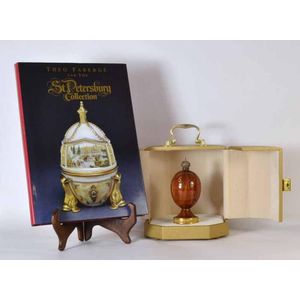French Gilt Spelter Madonna Clock Under Glass Dome
You must be a subscriber, and be logged in to view price and dealer details.
Subscribe Now to view actual auction price for this item
When you subscribe, you have the option of setting the currency in which to display prices to $Au, $US, $NZ or Stg.
- Spelter - Spelter was the name given to an alloy of zinc and brass or copper used in the 19th century for statuary and lighting. It is a brittle bluish-white metal. It was used as a cheap replacement for bronze, but being brittle easily breaks and can't be repaired. When finished it can often be mistaken for bronze, but if discreet a scratch on the base displays shows a greyish colour, the metal is spelter, if a golden colour the metal is most likely bronze.
- Pendulum - The pendulum was discovered around 1602 by Galileo Galilei, and was adopted for time keeping by the Dutch mathematician and natural philosopher, Christiaan Huygens, who excelled in astronomy, physics, and horology.
The pendulum comprises a metal rod usually of brass or steel with a metal disk, known as a bob, at the end. The movement of the pendulum is driven by weights or a spring, and as a pendulum swings in a regular arc, it was found accuracy could be controlled to within a few seconds a week.
Timekeeping can be adjusted by changing the height of the bob on the rod, making the pendulum either swing slower or faster.
The disadvantage of the pendulum was that changes in temperature also changed the length of the pendulum, interfering with the accuracy of the clock, and so in the 18th century two types of mercurial pendulums were invented which countered the movement in the steel rod.
The pendulum was the world's most accurate timekeeping technology until the invention of the quartz clock, regulated by a quartz crystal, in 1927.
This item has been included into following indexes:
Visually similar items

Antique French marriage dome, approx 45 cm high

A French Empire figural mantle clock under glass dome, circa 1820 a seated, classically draped youth sitting atop the clock case holding a lyre and scroll, the rectangular case is decorated with wreaths and musical instruments, 49.5 cm high

A Theo Faberge and the St Petersburg collection, 'The Eternity egg' limited edition, no 630. Manufactured England. The Eternity egg was released 1986, and made from bubinga wood, which is from Central Asia. The Imperial Crown of Russia is of vermeil with a

A decorative French 19th century gilt metal mantel clock adorned with a seated aristocrat, Sevres hand painted porcelain dial and floral panel. 33 cm high, 44 cm wide.
